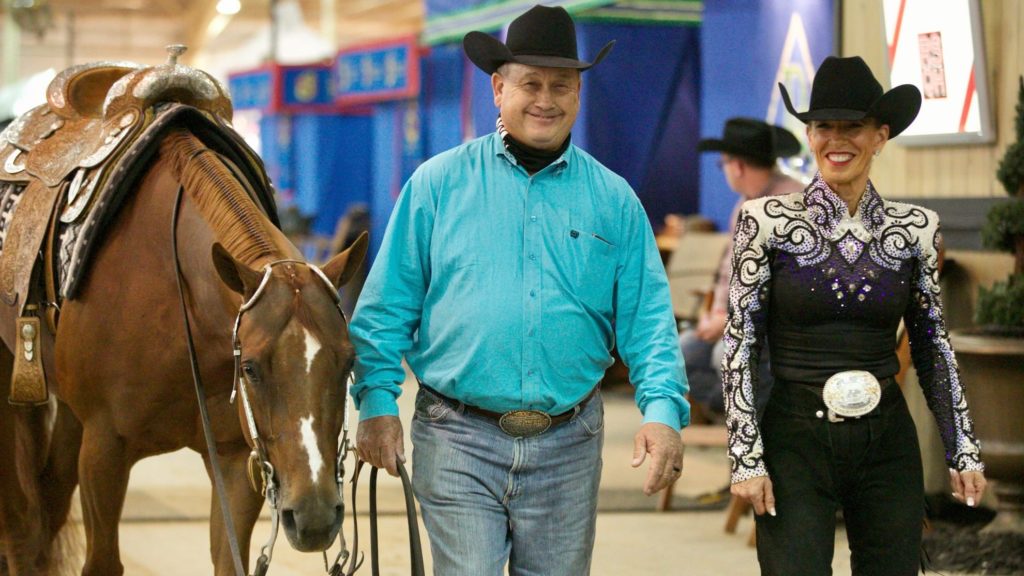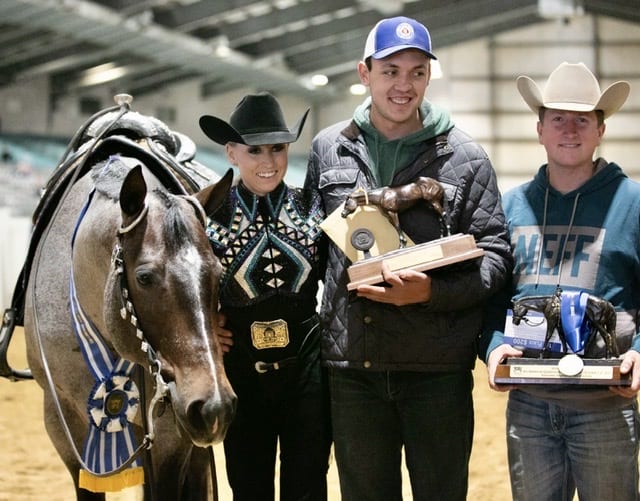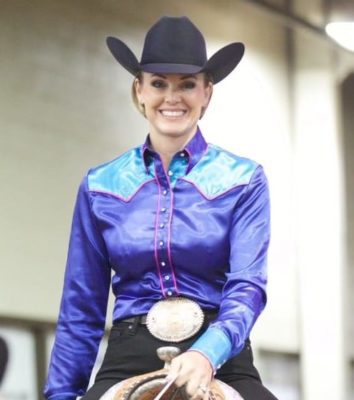The Congress is fast approaching and, as with other major shows, competitors are making their final preparations in hopes of setting themselves and their horses up for success when it matters most. A significant part of preparing for top-level shows involves more than the training, but it includes strategizing how to approach various classes. Having the right strategy is particularly relevant to performing well in patterns.
We spoke to leading industry trainers Melissa Jones (Jones Performance Horses), Bruce Walquist (Walquist Quarter Horses), and Adam Winter (Winter Performance Horses) to get their insights on helpful approaches to strategizing for success in the pattern classes at major shows like the Congress. When is the right time to play it a little safe? And when is the time to really go for it all and lay it all on the line?
 Bruce Walquist (The “Know Thyself” Approach): Walquist recommends looking at a pattern as parts of a whole instead of just one performance. He says this is a helpful perspective because each maneuver is scored separately, and each exhibitor/horse team has different strengths and weaknesses.
Bruce Walquist (The “Know Thyself” Approach): Walquist recommends looking at a pattern as parts of a whole instead of just one performance. He says this is a helpful perspective because each maneuver is scored separately, and each exhibitor/horse team has different strengths and weaknesses.
Indeed, there are some aspects in a pattern that you and your horse are better at than others. Therefore, he doesn’t recommend that exhibitors take the mindset of: I’m going to go “all-out” in this entire pattern. Instead, he tells us to think, “I’m going to go all-out in my strong maneuvers and play these others more safely because they are more difficult for my horse and me.”
For example, some horses struggle with backing or turning in the box in a trail pattern. He would recommend playing those maneuvers more slowly, thoughtfully, and safely to, at the bare minimum, avoid the subtraction of points. Conversely, that same horse may be fabulous at loping the wheel, so really make that a showpiece of your pattern so that the less-impressive box turn or back doesn’t hurt your overall score.
Walquist reminds exhibitors that a common mistake at shows like the Congress is watching another go and trying to mimic them because you liked the presentation. He says this is risky because “you’re not trying to sell their strengths; you’re selling your strengths.” So, while it can be helpful to watch others navigate a pattern, don’t let their plan steer you away from emphasizing your strengths and downplaying your weaknesses.
 Adam Winter (The “Tailored Practice Makes Individual Progress” Approach): Like Walquist, Winter is a firm believer in developing a plan for pattern classes unique to the horse/exhibitor combination. In addition, he believes that you set yourself up for success at shows like the Congress by adjusting your strategy at home and smaller, more low-pressure shows.
Adam Winter (The “Tailored Practice Makes Individual Progress” Approach): Like Walquist, Winter is a firm believer in developing a plan for pattern classes unique to the horse/exhibitor combination. In addition, he believes that you set yourself up for success at shows like the Congress by adjusting your strategy at home and smaller, more low-pressure shows.
Specifically, smaller shows are a great place to implement a strategy and practice it. In addition, these shows help build a foundation for a correct, clean pattern. Because there are fewer people in the classes, having a smooth, clean go is the key. However, large shows like the Congress, with tons of exhibitors, often require that you lay down a pattern that will stand out from the crowd and score high marks if you want to finish at the top.
Winter advises clients to practice different levels of effort at home and in small shows. Plan to push certain elements and hold back a little on others. Find out whether your horse can handle being pushed. Find out how your horse responds to being asked to push in one element and then “rein it in” and focus on another aspect.
If you practice different levels of effort in a single pattern and change your plan on the fly, you will be set up to make a plan and stick to it or adjust it as needed at the larger shows, without having a mental breakdown.
Additionally, Winter reminds exhibitors to practice more than the maneuvers themselves, but practice a mentality at home before big shows. Everyone responds differently to nerves and pressure. If you are the type of person who goes 1,000 mph when nervous, really practice moving through a pattern slowly and methodically so that it becomes muscle memory. Then, you won’t speed through your class when you inevitably get nervous.
If you’re the type of person who shuts down and becomes sluggish and dull under pressure, practice pushing through a pattern with energy and pep so it becomes muscle memory and you don’t fall apart when you’re nervous.
 Melissa Jones (The “Show Through What You Go Through” Approach): Jones reminds exhibitors that you only get one chance at a first impression. She advises that you plan to start the pattern with confidence and precision. Experienced exhibitors can adjust accordingly, but if you put energy into really focusing on a flawless start to the pattern, it is easier to recover from foibles later on. However, it can be hard to come back from if the pattern begins with a struggle or begins too conservatively.
Melissa Jones (The “Show Through What You Go Through” Approach): Jones reminds exhibitors that you only get one chance at a first impression. She advises that you plan to start the pattern with confidence and precision. Experienced exhibitors can adjust accordingly, but if you put energy into really focusing on a flawless start to the pattern, it is easier to recover from foibles later on. However, it can be hard to come back from if the pattern begins with a struggle or begins too conservatively.
Although it is essential to set the right tone from the onset of a pattern, Jones ascribes to the adage that “Life happens when you’re busy making plans for it.” So, while you can plan and practice a pattern to set up a particular strategy, your horse may have a different plan on game day.
Therefore, Jones recommends being flexible with a plan to make the best impression at the onset of the pattern or to help yourself recover from a poor impression. She reminds exhibitors that you need to “Show through what you go through!”
Specifically, you must keep showing regardless of whether you can stick to the plan or if you struggle with a particular maneuver. For example, she has found that clients will often feel like a specific maneuver went poorly, but will watch a video of the go and realize it wasn’t as bad as they thought. Jones says this is why it is so important to keep showing – if you give up after feeling an aspect of the pattern wasn’t up to snuff, you may be throwing away a decent pattern. Indeed, the judges don’t know your plan or what your best looks like – they can only judge what is in front of them.
Therefore, Jones advises you to aim to have your best ride with what you’re given. If the pattern starts beautifully, it may be wise to play it safer as it progresses – depending on how your horse feels and the difficulty of maneuvers for you later in the pattern.
If your pattern starts with some struggles, depending on the nature of those struggles, it may be worth it to put it all out there and try to push for positive points in the remainder of the pattern.
***
When taken as a whole, all of our experts recommend considering which elements of a pattern are your strengths and which are your weaknesses. Then, focus on emphasizing your strengths and minimizing the impact of your weaknesses on the overall pattern.
Make sure to practice implementing a plan and then learn to be comfortable adjusting that plan on the fly to preserve a great go or improve on a little less desirable go. Once you’ve done this, you can focus on creating the best impression and laying down your personal best pattern when it counts the most.









